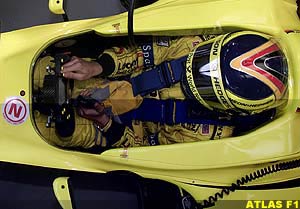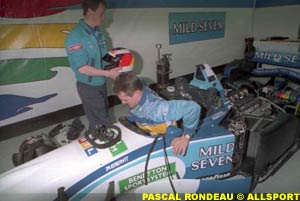|
Last year, Atlas F1 ran a series of articles that investigated the technical areas involved in design, development, and construction of an F1 car. Now, a year later, Will Gray picks up where he left off, and dives deeper into the technical analysis of Formula One.
9A. Are you sitting comfortably? - Cockpit Comfort
The cockpit is often termed 'the driver's office', for as well as all the time spent testing the car, it is in here on seventeen weekends each year that he must endure two grueling hours of racing. With every hundredth of a second being critical, the driver must be assisted perfectly by his equipment, and be comfortable within it.
 To measure human body size, anthropometric measurements (measurements of body sizes, such as arm length, height, etc) are used. These generally consider percentiles - percentages of the population. For instance, a road car would be designed such that the seat is movable in different ways to fit in as large a range of people as possible. In racing, the maximums and minimums are more clearly defined by the specific drivers chosen for the season, and the cars are specifically designed around them. Although ideal for a stable team, if there are injuries or driver changes, this can prove awkward - for instance, in allowing Nigel Mansell to test a Jordan in 1996, the chassis had to be specifically widened to fit his stature! To measure human body size, anthropometric measurements (measurements of body sizes, such as arm length, height, etc) are used. These generally consider percentiles - percentages of the population. For instance, a road car would be designed such that the seat is movable in different ways to fit in as large a range of people as possible. In racing, the maximums and minimums are more clearly defined by the specific drivers chosen for the season, and the cars are specifically designed around them. Although ideal for a stable team, if there are injuries or driver changes, this can prove awkward - for instance, in allowing Nigel Mansell to test a Jordan in 1996, the chassis had to be specifically widened to fit his stature!
A scan of stats for the drivers racing in Formula One in 1999 shows weights ranging from 58kg to 76kg, with heights in the range of 167cm to 187cm. This can make it difficult for some teams, for instance, Benetton, with diminutive Italian Giancarlo Fisichella and Austrian giant Alex Wurz, had one of the most difficult packaging problems in the pit lane. On the one hand they wanted to take advantage of Fisichella’s small build, and on the other, they couldn’t compromise Wurz’s comfort in the car. Designing is a difficult game!
The seating set-up in a Formula One car is one of ultimate fit. A seat is manufactured by sitting the driver, in his full race suit, in a bag full of setting foam positioned inside the car. The driver can choose to have either an arched or a straight back, and once the seat is moulded, it is a perfect fit to the contours of the drivers body. There is no cushioning for comfort, in fact there is no room for movement once the seatbelts are done up tightly. This means that in racing, the race suit worn by the driver can be tight fitting or baggy, but the body movement is constrained to virtually nil by the seat and belts.
For the driver’s safety, the cockpit is ‘covered’ by the template of the roll structure - an angled line from the top of the roll hoop (hidden inside the air intake above the driver's head) and the front of the cockpit. As long as his head is below this, he can be positioned at any chosen angle in the car. Some drivers like to have a laid back position, others prefer to sit more upright, and the chassis design allows for this choice to be made. In laying back, more strength is required to turn the wheel, but it is aerodynamically efficient and good for the centre of gravity, so is greatly encouraged by designers!
 The driver's positioning also affects his line of sight. With different positions, different drivers’ heads will be at different heights, but generally the eyeline is positioned above a small perspex screen (which is in fact an air deflector), but the limits of sight are actually defined by the drivers helmet visor opening and not the cockpit itself. Rear sight is obtained through standard rear-view mirrors, although much of the view tends to be blocked by the rear wing - especially on high downforce circuits. Rear view cameras are not an option as there is no space in the cockpit to fit them, and they would be an unwelcome weight increase. The driver's positioning also affects his line of sight. With different positions, different drivers’ heads will be at different heights, but generally the eyeline is positioned above a small perspex screen (which is in fact an air deflector), but the limits of sight are actually defined by the drivers helmet visor opening and not the cockpit itself. Rear sight is obtained through standard rear-view mirrors, although much of the view tends to be blocked by the rear wing - especially on high downforce circuits. Rear view cameras are not an option as there is no space in the cockpit to fit them, and they would be an unwelcome weight increase.
The reach of the driver is a critical, and the steering wheel is positioned to be held with arms slightly stretched, but brought close to the body. Having fully outstretched arms is a bad driving position, as the driver must support the arms full weight - which, when totaled up, is 5.1% of the overall body weight. In a road car, arms are often rested on ledges, but here, the steering is relatively stiff, and the wheel provides good support for the arms. Also, the wheel is designed in such a way as to allow thumbs to rest on the spokes, giving further support, so elbow supports (which would get in the way) are not required.
The chassis is quite narrow on the cockpit area, and some teams have small bulges on the outside of the chassis where indents have been made for driver elbow movement. The compromise here is one between comfort and aerodynamics. Any bulges in a surface are bad for aerodynamics, but so is a generally wide cockpit, so the designers make the cockpit as narrow as possible within the confines of comfort. If they overdo it, bulges must protrude, as with the so-called 'power bulges' which make similar adjustments for unexpected protruding engine parts.
Towards the driver’s feet, the chassis narrows. Here can be found the two pedals, the brake and the throttle - the gearbox is semi-automatic, so doesn't require a clutch to change up or down the gears. A modern technique for driving is to left foot brake, so each foot is used for a different operation. This means the pedals can have a wider separation to reduce the chance of misuse. If the driver prefers right foot braking, the pedals must be positioned closer to allow the foot to move easily between them, but the current trend is to encourage drivers to use the new technique. This is especially the case, when considering the car set-up. Often a team will only have one spare car, which will be set-up for either the number one driver, or the driver selected for that particular race.
 As explained, drivers' cockpit profiles can differ considerably in position, spine curvature, pedal position, and reach to the wheel. If the driver not allocated to the spare has a problem in qualifying or before the start of the race, the car must have the ability to be changed to fit that driver in little more than a blink of an eye. This is made easier if the two drivers have the same braking technique, and is simplified generally by having ready-made spacers and fittings to change the pedal and steering wheel set-up. The seat is bolt on-bolt off, with the same fixings, so is very quick to change, and the cockpit set-up can indeed be changed rapidly. Of course, there is also the car characteristics set-up to change, such as suspension and aero set-up, and engine mapping, all mentioned earlier, and it is this which takes more time. As explained, drivers' cockpit profiles can differ considerably in position, spine curvature, pedal position, and reach to the wheel. If the driver not allocated to the spare has a problem in qualifying or before the start of the race, the car must have the ability to be changed to fit that driver in little more than a blink of an eye. This is made easier if the two drivers have the same braking technique, and is simplified generally by having ready-made spacers and fittings to change the pedal and steering wheel set-up. The seat is bolt on-bolt off, with the same fixings, so is very quick to change, and the cockpit set-up can indeed be changed rapidly. Of course, there is also the car characteristics set-up to change, such as suspension and aero set-up, and engine mapping, all mentioned earlier, and it is this which takes more time.
The intense heat environment, along with vibrations and stiff suspension means two hours can be a grueling race if you're not sitting comfortably. For this, cockpit comfort is worth seconds in a race.
|

